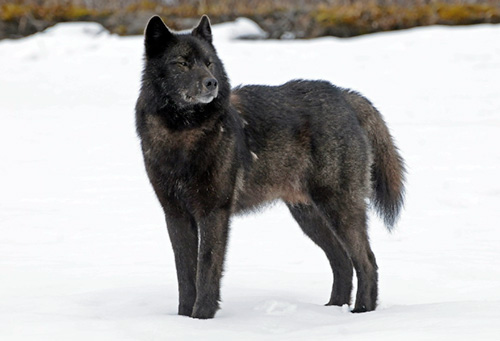
Old-Growth Logging The True Culprit Behind Drastic Wolf Declines in the Tongass Says Report
October 18, 2015
Sunday PM
(SitNews) - In response to an Alaska Department of Fish and Game report in May that revealed a drastic decline in the wolf population on Prince of Wales and surrounding islands, Audubon Alaska’s science and policy team developed a report, Prince of Wales Wolves, examining the underlying reason for the decline.
Audubon Alaska’s science and policy team's concluded large-scale, old-growth, clearcut logging to be the culprit behind the wolf population decline on Prince of Wales and surrounding islands

Tongass Wolf
Image from the Long-Term Impact of Logging and Roads Push A Tongass Wolf Population Toward Extinction Report
Image By: J. Cannon, B. Armstrong
“The alarming population decline is most immediately caused by the direct take of wolves from significant poaching and the unsustainable legal take authorized by the Alaska Department of Fish and Game, but the underlying cause is extensive logging and roads that initiate many harmful effects, including overharvest of wolves,” said Melanie Smith, Audubon Alaska’s Director of Conservation Science.
The May 2015 ADFG report said the recent population dropped from 221 wolves to only 89 in the span of a year, before logging on the Big Thorne timber sale - the largest old-growth sale in the Tongass in nearly 20 years - began this summer.
The new Audubon Alaska report points out three ways old-growth logging has and will continue to drastically impact the wolf population on Prince of Wales:
- 4,200 miles of logging roads on Prince of Wales and surrounding islands allow poachers easy access into wolf habitat.
- Clearcutting old-growth trees removes crucial winter habitat for wolves’ main prey, Sitka black-tailed deer, ultimately resulting in a lower deer population.
- The reduced deer numbers, in turn, make some people perceive wolves as competition for hunting, “leading to increased poaching and public pressure to authorize unsustainable legal limits on wolf take to drive down the wolf population.”
According to Audubon Alaska, the bottom line is the decline of wolves is a management problem that desperately needs fixing.
The Audubon Alaska report offers three steps necessary for survival of wolves on Prince of Wales Island:
- Halt hunting and trapping until the wolf numbers return to a sustainable level.
- End large-scale old-growth logging on Prince of Wales and the surrounding islands while closing unnecessary roads.
- Protect the wolves in the Prince of Wales region under the Endangered Species Act.
Edited by Mary Kauffman, SitNews
On the Web:
The Long-Term Impact of Logging and Roads Push A Tongass Wolf Population Toward Extinction
http://www.sitnews.us/1015News/101815/
prince_of_wales_wolves_15oct2015.pdf
Download Executive Summary: Prince of Wales Wolves, examining the underlying reason for the decline
http://www.sitnews.us/1015News/101815/
prince_of_wales_wolves_15oct2015_executive_summary.pdf
Source of News:
Audubon Alaska
www.AudubonAlaska.org
Publish A Letter in SitNews
Contact the Editor
SitNews ©2015
Stories In The News
Ketchikan, Alaska
|
Articles &
photographs that appear in SitNews may be protected by copyright
and may not be reprinted without written permission from and
payment of any required fees to the proper sources.
E-mail your news &
photos to editor@sitnews.us
Photographers choosing to submit photographs for publication to SitNews are in doing so granting their permission for publication and for archiving. SitNews does not sell photographs. All requests for purchasing a photograph will be emailed to the photographer.
|
|

